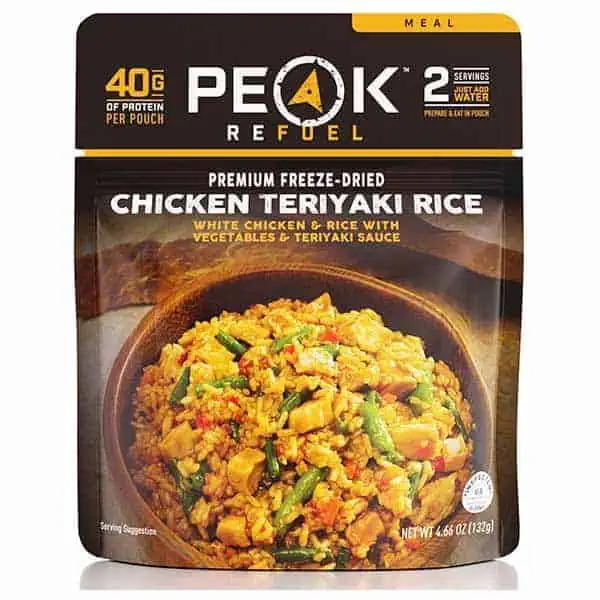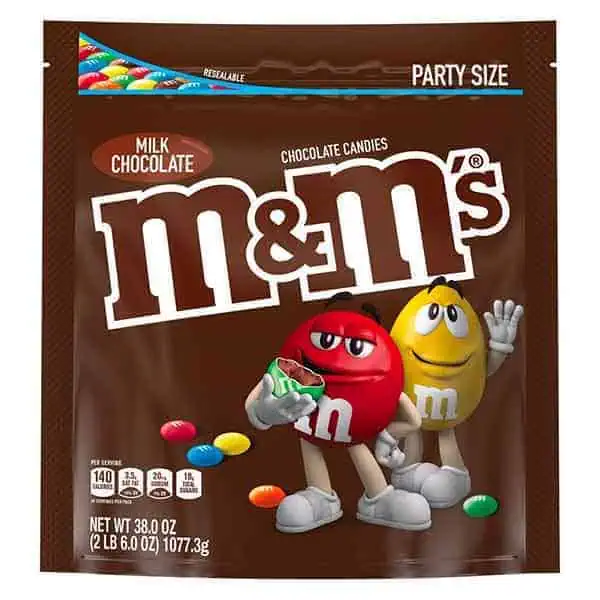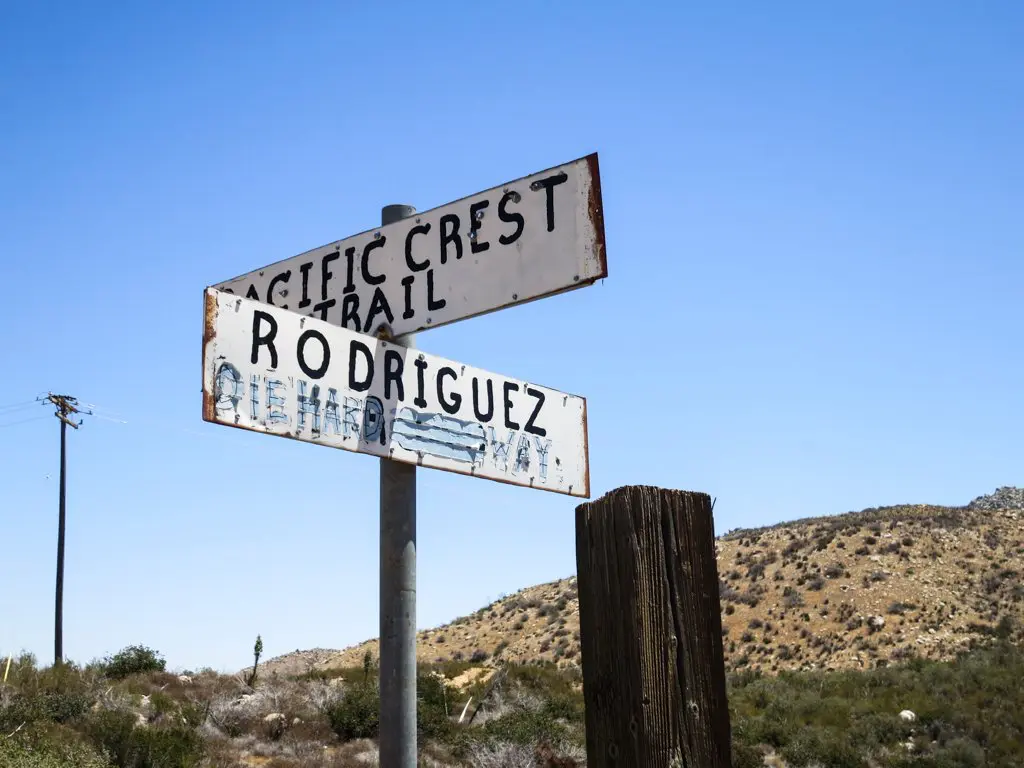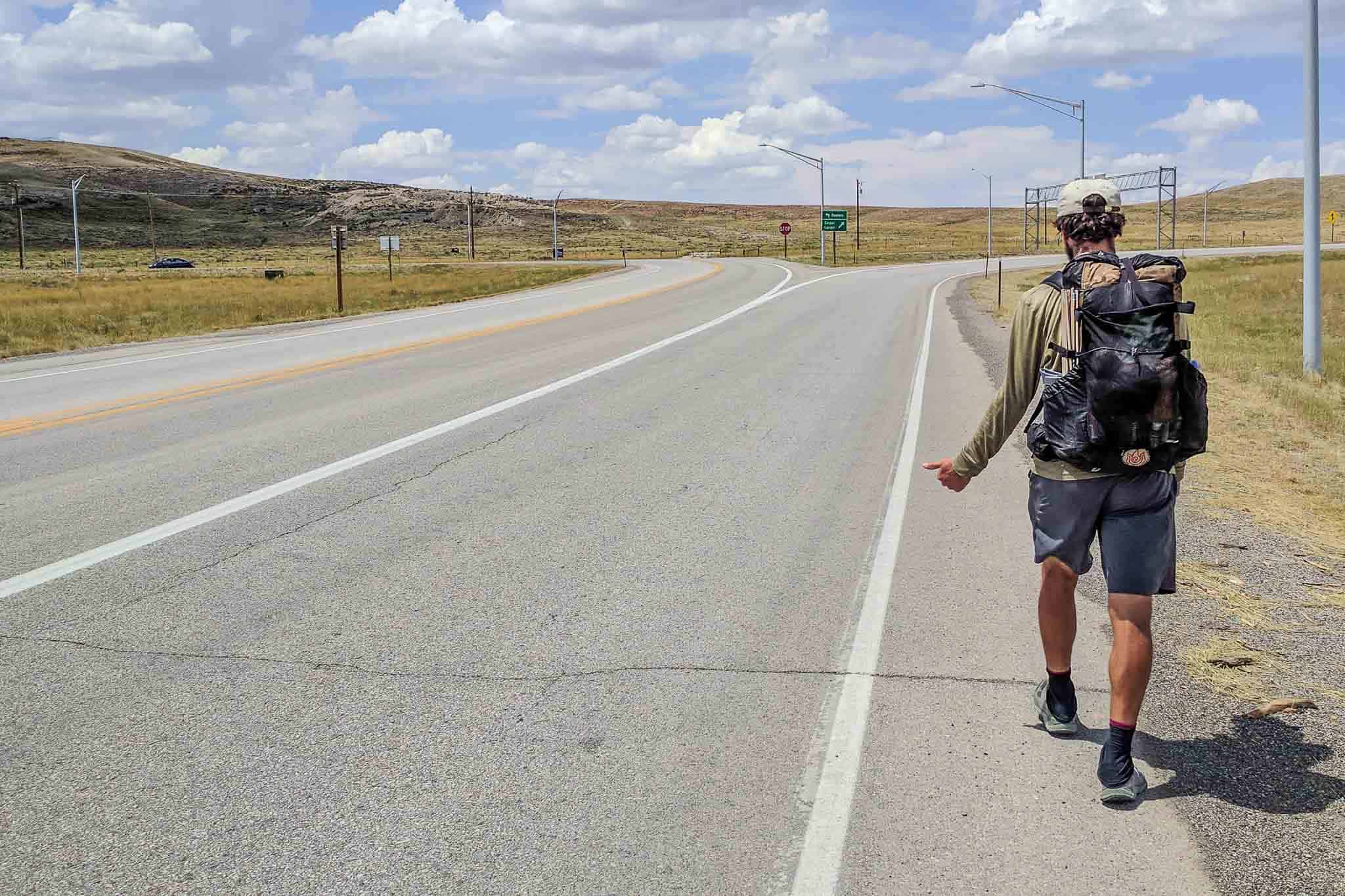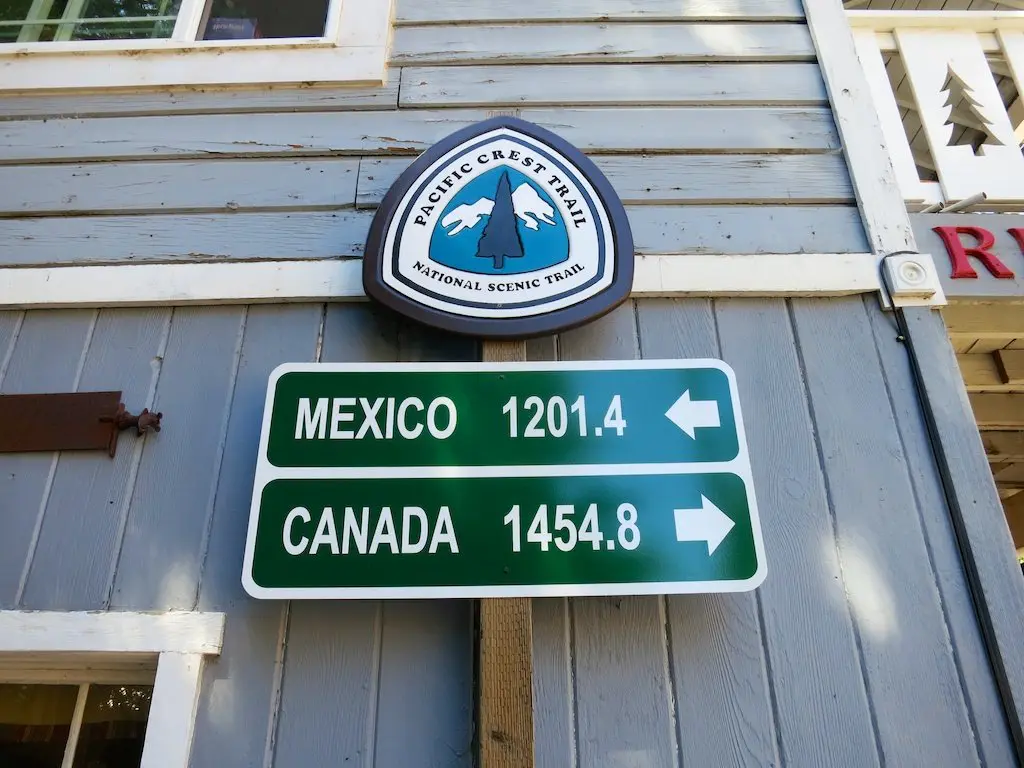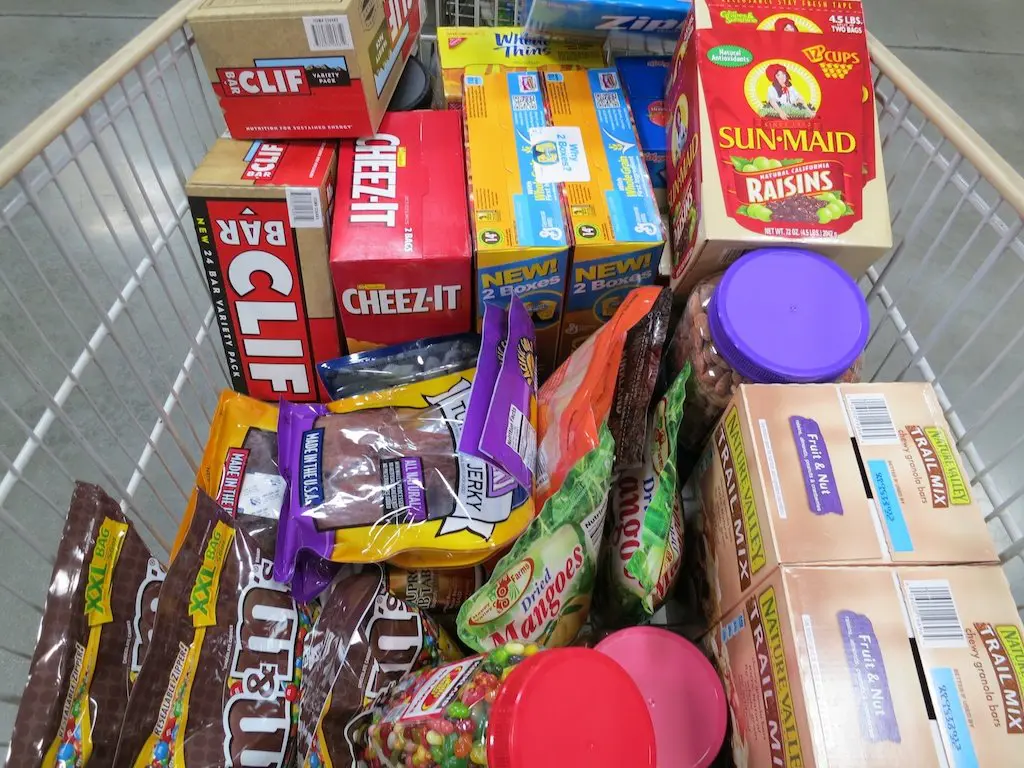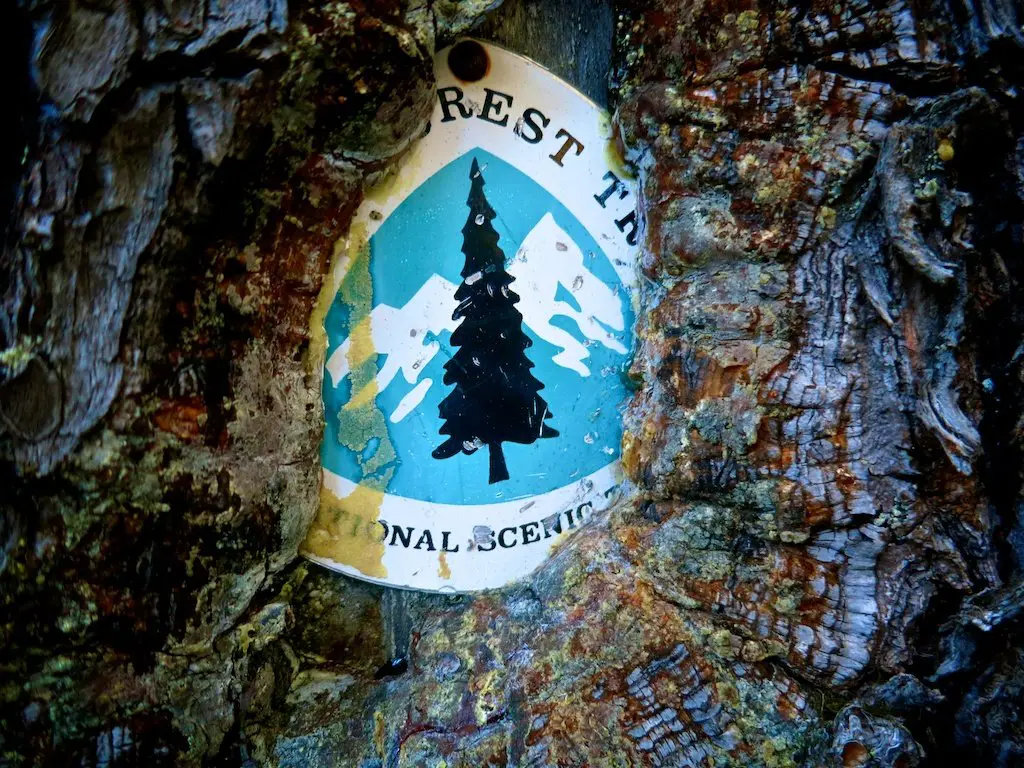Pacific Crest Trail Resupply Guide (2022 Survey)
In the third installment of the Pacific Crest Trail Thru-Hiker Survey, we cover what’s probably the biggest (perceived) logistical issue on the PCT, resupply. After hikers get their gear sorted, questions surrounding resupply become the object of PCT hiker fascination.
What is PCT resupply? It’s the replenishment of the food (and other consumable items) carried in a hiker’s backpack. Basically, buying more food and supplies on the trail. Contrary to popular belief, PCT hikers commonly leave the trail and venture into towns to buy more food; they don’t carry all their food (for the entire hike) from the beginning. And, perhaps even more shockingly, the idea that thru-hikers subsist on a diet of foraged mushrooms and edible plants is a lie.
I often advise hikers not to worry about resupplying before beginning a thru-hike, but I am not always believed. Barring any dietary restrictions or a tight resupply schedule (i.e. you’re on a PCT speed run), there’s little reason to stress about where you’re going to buy food in Northern California in a couple of months. The Pacific Crest Trail runs society adjacent and it isn’t difficult to get yourself to somewhere where you can pause and organize yourself and your hike.
Using data from the 2022 Pacific Crest Trail Hiker Survey, I’ve compiled the following picture of what resupply looks like over the course of a Pacific Crest Trail thru-hike. Hopefully, this helps all you would-be PCT thru-hikers rest a little easier.

Notes on the Data
- This year has 953 completed surveys – a 38% increase versus last year and the most ever completed in a single season
- Some responses are sorted and colored to make the data friendlier – e.g. northbound or southbound. More on this below.
- The Pacific Crest Trail and thru-hiking in general come with a lot of acronyms and jargon you’re likely unfamiliar with if you’re new to the world of border-to-border foot travel. If you find anything unclear, the thru-hiker glossary may be of use. If you still can’t find what you’re looking for, feel free to drop a comment and let me know.
- I ask that respondents do their best to accurately respond to questions. Not every hiker answers every question and not every answer is guaranteed 100% accurate (e.g. someone may mistakenly report sending 8 boxes instead of 9).
- I refer to survey respondents collectively as this year’s “class“. Remember, this is a sample (albeit a large one) and not a comprehensive survey of every person on the PCT this year.
- The results invoke some math. I suggest you familiarize yourself with the words average, median (M), and standard deviation (σ) if you’re looking to get the most out of your time here.
- Stats requiring the length of the PCT use 2,653 mi / 4,270 km (the distance used in the FarOut Guides PCT app) for calculations.
- More PCT Survey posts focused on breakdowns of women-specific gear and couples’ gear, PCT Demographics, PCT Horror Stories, and PCT Advice are in the works. If you missed it, here are this year’s Survey Results and the Gear Breakdown. If you would like to be notified of new surveys, sign up here.
Colors differentiating hiker segments:
- Thru-Hikers
- Northbound Thru-Hikers
- Southbound Thru-Hikers
- The number (1) will be appended when only using data from hikers who completed the trail
- The number (0) will be appended when only using data from hikers who did not complete the trail
If no color/label has been appended to a data point, I used all data collected (i.e. it also includes section hiker data and data from hikers who did not complete the trail).
Resupply Strategy
When you find yourself in town along the Pacific Crest Trail, you have the following options in terms of your resupply:
- Buy a full resupply (replenish your food stocks from zero back to a level sufficient to get you to the next resupply point)
- Buy a partial resupply (boost your current stock to get you through to the next resupply point – i.e. get more snacks)
- Pick up a package from a post office or hiker-friendly place along the trail (like a hotel or trail angel) that you’ve sent ahead to yourself.
- Get yourself a large enough meal to hold yourself over until the next town (some hikers are fond of doing this at the Cajon Pass McDonald’s).
- Skip the town completely and crush miles to your next resupply.
Occasionally, your options are limited to a gas station or an overpriced general store (which is where some hikers may prefer to send themselves packages). Other times, you’ll find yourself in a large town with a supermarket (this is a good place to get a resupply to send ahead somewhere).
Before delving into the “best” strategy for PCT resupply, I must warn you (again) to not fall into the trap of attempting to plan your entire hike ahead of time. It (probably) is not going to work out the way you expect (although I’ve been proven wrong in the past).
Unless you have very specific dietary restrictions or a compelling reason to do so, there is little reason to plan your resupply stops ahead of time. It’s like worrying about how you’re going to get home when you reach the northern/southern terminus; it doesn’t matter to you who has yet to walk a single step. There will be plenty of time on the trail to figure out your resupply, trust me (I’m an internet stranger, so you basically have to).
With this in mind, let’s take a look at the PCT Class of 2022’s resupply.
Resupply Boxes
Buying your food and prepping boxes before your hike can be tempting for the first-time thru-hiker – even the experienced, but uncertain thru-hiker). A certain (false) sense of security comes from packing up resupply before the trail – a kind of “well, I’ve got all that sorted out”. Except on the trail, all of that planning/sorting you did ahead of time can prove more of a liability than an asset.
Plans change, post offices aren’t always open, boxes get lost, and hikes end early – a lot can happen between your start date and the resupply box you hop(ed) to retrieve weeks or months later.
On top of that, unless you’ve done a long-distance hike before (and based on the statistics from the PCT Survey – you probably haven’t), it can be hard to imagine what you, in a month (or two…or three…), are going to want to eat all day.
But since practically all hikers send at least one box, let’s examine how many boxes were sent, how many were prepped ahead of time, how frequently they were sent, and what was done before starting vs. on the trail.
Resupply Strategy
- 1.9% Mailed all resupply
- 7.4% Mailed most resupply (> 50%)
- 44% Mailed some resupply (10-50%)
- 37.2% Mailed a few resupply (1-10%)
- 9.5% Mailed no resupply

2022 Thru-Hikers
- 1.9% Mailed all resupply
- 7.4% Mailed most resupply (> 50%)
- 44.0% Mailed some resupply (10-50%)
- 37.2% Mailed a few resupply (1-10%)
- 9.5% Mailed no resupply
2021 Thru-Hikers
- 2.7% Mailed all resupply
- 10.2% Mailed most resupply (> 50%)
- 48.4% Mailed some resupply (10-50%)
- 30.2% Mailed a few resupply (1-10%)
- 8.4% Mailed no resupply
As with most years (every year), the vast majority of hikers split their resupply between buying locally and sending boxes ahead.
Number of Resupply Boxes
This is a chart of the total number of resupply boxes by thru-hikers who completed the entire Pacific Crest Trail.
Average: 7.5
Median: 6
σ: 5.3

Resupply Boxes Prepared Pre-Trail
As part of PCT resupply planning, many hikers prepare resupply boxes ahead of time. Here are the stats for the number of boxes that thru-hikers prepared before setting foot on the trail.
Average: 3.6
Median: 1
σ: 8.3
Note: You can buy and prepare resupply boxes from on the trail; you don’t need all of your boxes ready before you even begin your hike.

Boxes Mailed from the Trail
As many PCT hikers learn (and what I’m here to tell you now) is that you can mail yourself resupply boxes from the trail. This strategy is a smart one because you will not only have a better idea of your daily mileage and your food preferences after you begin hiking, but you’ll be able to make sure you don’t waste time and money ahead of time prepping resupply boxes you may end up hating or never even using (if you have to get off the trail for some reason or skip a section due to fire, snow, or trail closures).
Here are the stats for the number of boxes that thru-hikers who finished sent to themselves while on the trail.
Average: 4.9
Median: 5
σ: 3.9

Thru-Hikers (1)
27%
The percentage of hikers who said they would have liked to have sent fewer resupply boxes during a thru-hike
Thru-Hikers (1)
9
The average number of resupply boxes sent by hikers who said they would have liked to have sent fewer resupply boxes
Thru-Hikers (1)
7.5%
The percentage of hikers who said they would have liked to have prepared no resupply boxes before beginning their thru-hikes
Thru-Hikers (1)
16.7%
The percentage of hikers who said they would have liked to have sent more resupply boxes during a thru-hike
Thru-Hikers (1)
7
The average number of resupply boxes sent by hikers who said they would have liked to have sent more resupply boxes
Thru-Hikers (1)
1.7%
The percentage of hikers who said they would have liked to have prepared all their resupply boxes before beginning their thru-hikes
This year’s average number of boxes sent was 7.5, the median was 6, people who sent 7 wanted to send more, and people who sent over 99 wanted to send fewer. Sounds like the average of 8 is what this year’s class wanted.
Remember, there is no correct “number of PCT resupply boxes”, but there are most-definitely places where a prepackaged and curated selection of your own preferences will be preferable to the local selection.
Where to Mail PCT Resupply Boxes
As part of the PCT Survey, I ask hikers where they definitely recommend sending a resupply box. Hikers’ motivations for sending a resupply box to a location on the trail can range from “the selection is bad and everything is expensive” to “the owners of the store are awful people”. Regardless of their reasons, here’s where the PCT Class of 2022 thinks you should send yourself resupply boxes.
In case there’s any confusion, the locations are listed in descending order (not geographical order). The percentages reflect the percentage of this year’s class who indicated that they would “definitely send a resupply box” to each location. Remember, this year’s class agreed upon sending just over nine resupply boxes; I’ve included 10 to give you options (because, you know, hike your own hike, etc).
- Stehekin* (Washington) 71%
- White Pass (Washington) 35.6%
- Stevens Pass/Skykomish (Washington) 32%
- Crater Lake National Park (Oregon) 31.4%
- Snoqualmie Pass (Washington) 30.8%
- Acton KOA/LA RV Resort (Desert) 29.3%
- Shelter Cove Resort (Oregon) 27.8%
- Kennedy Meadows (South)^ (Sierra) 26.7%
- Sierra City (Northern California) 26.1%
- Warner Springs (Desert) 17.1%
*This is the fourth year in a row Stehekin has been (overwhelmingly) at the top of the list.
^Kennedy Meadows (South) is where most (northbound) hikers begin carrying bear canisters. The most common bear canister every year on the PCT? The BV500. Personally, I’m a fan of the BV450 (but I own a Scout since I find myself in bear territory frequently), but more on that in the gear guide.
Before you plan all of your boxes and resupply stops, remember that for the first 1,700 mi / 2,700 km of the Pacific Crest Trail (assuming a northbound thru-hike), the PCT Class of 2022 suggests you send three boxes (the same as last year’s class).
Many hikers fail to realize that you can easily send yourself boxes from towns on the trail (instead of having to prepare your boxes ahead of time). You are not committed to the plans you have when you begin the trail; if you have (for some reason) planned every one of your stops, there’s no reason you have to stick to that plan.
The PCT is long. But it simply connects a series of smaller trails between resupply stops. Nothing is stopping you from going to a supermarket, buying yourself delicious hiker food, and mailing it to yourself further up the trail (unless it’s Sunday because the post office is closed on Sunday – and sometimes Monday – which may sound unimportant now, but will be an important thing to remember whilst on the trail).
For the sake of simplicity, suppose you’re strictly following the averages of this year’s PCT class. The number of resupply boxes that you will send to each section of the PCT is:
- Desert: 2
- Warner Springs, Acton KOA/LA RV Resort
- Sierra: 1
- Kennedy Meadows South
- Northern California: 1
- Sierra City
- Oregon: 2
- Crater Lake National Park, Shelter Cove Resort
- Washington: 4
- White Pass, Snoqualmie Pass, Stevens Pass/Skykomish, Stehekin
Changes to PCT Resupply Strategy
To help future Pacific Crest Trail hikers figure out a successful PCT resupply strategy, I ask hikers what they would have changed as far as resupply. This year, 66.5% of thru-hikers said they would change something about their resupply strategy.
Of those who said they would like to change something, here are the responses.
- 27.0% – Send fewer resupply boxes over the course of the trail (9 was the average number of boxes sent by hikers who said this)
- 23.1% – Include more variety in their resupplies (Clif Bars and Stroopwafels will only get you so far)
- 22.2% – Include healthier food in their resupplies (yes, you can survive on M&M’s – but should you?)
- 18.9% – Mail resupply boxes from on the trail instead of ahead of time
- 16.4% – Send more resupply boxes over the course of the trail (7 was the average number of boxes sent by hikers who said this)
- 14.3% – Include less food in their resupplies (the challenge of how much food to buy remains constant over the course of the trail)
- 13.7% – Resupply more frequently (more frequent resupplies means less weight carried – but also more time in town)
- 7.5% – Prepare no resupply boxes ahead of time
- 6.9% – Resupply less frequently (less frequent means longer distance between resupplies)
- 6.0% – Send more food in their resupplies
- 5.8% – Send zero resupply boxes
- 1.7% – Prep all their resupply boxes ahead of time
- 1.2% – Send all resupply as boxes

Favorite Hiker Meals & Snacks
Another Pacific Crest Trail resupply consideration? What foods are you going to be resupplying with?
Personally, I would love to eat a Costco-sized bag of M&M’s with a large brick of cheese and a bottle of Sriracha for each section of trail, but I’ve been told this isn’t healthy (and 22% of PCT hikers said they wish they had resupplied with healthier food).
So what do PCT hikers eat? Berries, insects, dirt, fallen PCT hikers? Obviously. But there’s so much more on offer at (most of the) PCT resupply stops.
Here are this year’s favorite dehydrated meals and backpacking snacks.
Favorite Backpacking Meals
- Peak Refuel Meals 41.4%
- Knorr Rice Sides 33.7%
- Mountain House Meals 30.7%
- Backpackers Pantry Meals 27.6%
- Good To-Go Meals 15.5%
- AlpineAire Foods 9.4%
- Greenbelly Meals 9.1%
- Food for the Sole 5.8% (out of business 😢)
- Fernweh Food Company 5.1%
- Patagonia Provisions 4.1%
Favorite Backpacking Snacks
- M&M’s 36.5%
- Lenny & Larry’s Complete Cookies 31.3%
- Snickers Bars 30.8%
- Potato Chips 26.9%
- Peanut Butter 24.9%
- Trail Mix Snacks 19.5%
- Bobos Oat Bars 19.3%
- Clif Bars 18.7%
- Pro Bars 17.9%
- Nature’s Bakery Fig Bars 17.4%
How Frequently to Resupply
Predicting (with any degree of accuracy) where you will resupply before beginning a thru-hike, is something a lot of hikers attempt to do despite my telling them it’s not necessary. Do you know how long it’s going to take you to walk 100 mi / 160 km two months into your hike with three days of unscheduled rain and too much food in your pack?
The weather, your physical condition, the people you’re with, where you’ve just come from, where you’re going, and so many other factors make this a (somewhat) educated guess at best.
Maybe you’re going to prefer carrying more food and resupplying less often. Maybe you’re going to prefer a lighter load with more frequent stops in town. Maybe you’re going to be injured or quit in the first week (or die) and none of this will even matter.
So what’s the right balance between resupplying and hiking? It’s different for everyone. This a response that many of you may not want to hear, but also the most accurate response I can offer you. That said, here’s a look at what this year’s hikes looked like regarding resupply.
Thru-Hikers (1)
148
The average number of days it took hikers to complete the PCT
(M = 149 | σ = 22)
Thru-Hikers (1)
17
The average number of zero days taken during a thru-hike
(M = 15 | σ = 9)
Thru-Hikers (1)
16
The average number of nearo days (low mileage days)
(M = 15 | σ = 8)
Northbound Hike Breakdown
The following is the average number of days Northbound (1) hikers took to complete each section.
- 44 – The Desert
- 30 – The Sierra
- 34 – Northern California
- 19 – Oregon
- 30 – Washington
- 148 – The entire PCT
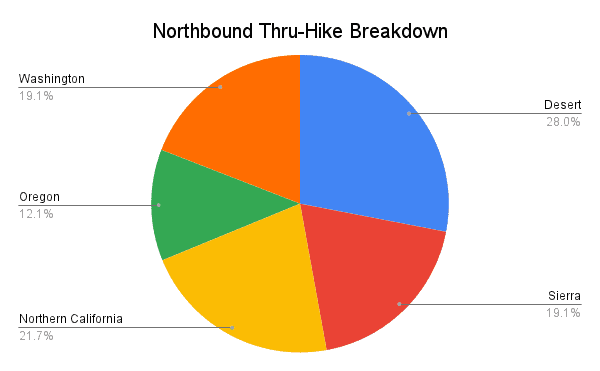
Southbound Hike Breakdown
The following is the average number of days Southbound (1) hikers took to complete each section.
- 37 – Washington
- 22 – Oregon
- 29 – Northern California
- 23 – The Sierra
- 44 – The Desert
- 135 – The entire PCT
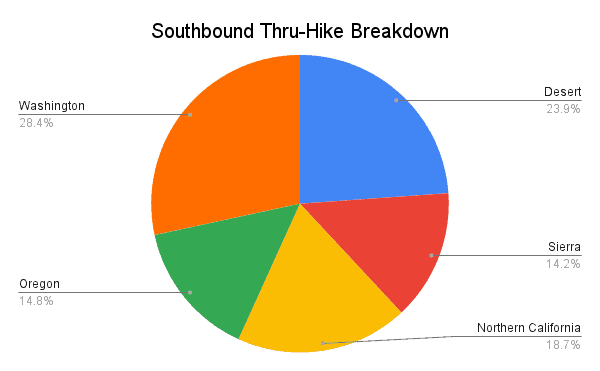
Thru-Hikers (1)
31.4
The average number of resupplies over the entire trail
(M = 32 | σ = 5.3)
Thru-Hikers (1)
4.7
The average number of days between resupplies
(M = 4.7 | σ = 1.2)
Thru-Hikers (1)
87.3
The average number of miles between resupplies (140.5 km)
(M = 83 mi / 133 km | σ = 16 mi / 26 km)
Average Resupplies Per Section
- 9.2 Desert (M=9)
- ~ every 76 mi / 122 km
- 4.8 Sierra (M=5)
- ~ every 81 mi / 130 km
- 7.3 Northern California (M=7)
- ~ every 86 mi / 138 km
- 5.5 Oregon (M=5)
- ~ every 89 mi / 143 km
- 5.1 Washington (M=5)
- ~ every 99 mi / 159 km

Stretches between resupply can vary greatly (for example, if you want to attempt a Kennedy Meadows to VVR resupply) and some will be a lot longer (or shorter) than others, but this should give you a rough idea of what to expect out there.
Average PCT Resupply Plan
Based on survey responses we can piece together what an “average” Pacific Crest Trail hiker’s resupply looked like for a 2021 thru-hike. Below is a list of all the PCT resupply stops where hikers stopped this year accompanied by the percentage of hikers who stopped at each location.
Resupply stops are listed in geographical order from Mexico to Canada (that’s south to north in case you’re unsure) and, again, I use the following colors to indicate each resupply stop’s popularity: over 75%, 50-75%, 25-50%, less than 25%. Locations marked with a 🏕️ can be reached without hitchhiking or road walking.
Desert Resupply
- 🏕️ Campo – 10.8%
- 🏕️ Lake Morena – 20.9%
- 🏕️ Mount Laguna – 50.6%
- Julian – 73.7%
- Montezuma Valley Market – 34.6%
- 🏕️ Warner Springs* – 43.5%
- 🏕️ Paradise Cafe – 14.8%
- 🏕️ Idyllwild – 89.6%
- Anza – 1.6%
- Cabazon – 23.7%
- Banning – 7.7%
- Palm Springs – 8.2%
- 🏕️ Cajon Pass – 29.1%
- Big Bear City – 36.4%
- Big Bear Lake – 59%
- Wrightwood – 84.8%
- 🏕️ Acton KOA/LA RV Resort* – 45.8%
- Acton – 26.8%
- 🏕️ Agua Dulce – 19.5%
- Palmdale – 4.5%
- Lancaster – 2.2%
- 🏕️ Hikertown – 50.8%
- Wee Vill Market – 14.7%
- Tehachapi – 89.8%
- Mojave – 4.5%
- Onyx – 1.2%
- Lake Isabella – 10%
- Kernville – 8.8%
- Ridgecrest – 40.1%
Sierra Resupply
- 🏕️ Kennedy Meadows* – 58.7%^
- 🏕️ Grumpy Bears Retreat – 23%^
- 🏕️ Triple Crown Outfitters – 61.9%^
- Lone Pine via Horseshoe Meadow – 22.4%
- Independence via Horseshoe Meadow – 1%
- Bishop via Horseshoe Meadow – 7.1%
- Lone Pine via Kearsarge Pass/Onion Valley – 11.7%
- Independence via Kearsarge Pass/Onion Valley – 7.8%
- Bishop via Kearsarge Pass/Onion Valley – 65.6%
- 🏕️ Muir Trail Ranch – 3.4%
- Bishop via Bishop Pass/South Lake – 5.5%
- Bishop via Piute Pass/North Lake – 0.4%
- 🏕️ Vermilion Valley Resort – 36.5%
- 🏕️ Red’s Meadow – 10.9%
- 🏕️ Mammoth Lakes – 86.6%
- 🏕️ Tuolumne Meadows – 43.7%
- 🏕️ Yosemite Valley – 15.8%
- Lee Vining – 5.9%
- Bridgeport – 3.7%
- Kennedy Meadows North – 83.7%
- Strawberry – 0.3%
- Markleeville – 4.1%
^All these locations are located in Kennedy Meadows (South) – at the same point in the PCT
Northern California Resupply
- 🏕️ Echo Lake – 6.8%
- 🏕️ South Lake Tahoe – 91.1%
- Stateline – 0.6%
- Sacramento – 1.9%
- Tahoe City – 3%
- Soda Springs – 1.9%
- Truckee – 41.3%
- Reno – 2.3%
- 🏕️ Sierra City* – 78.5%
- Quincy – 46.8%
- Chico – 1.9%
- Chester – 63.8%
- 🏕️ Bucks Lake – 1.7%
- Caribou Crossroads – 9.2%
- 🏕️ Belden – 34.9%
- 🏕️ Old Station – 38.5%
- 🏕️ Burney Falls – 12.5%
- Burney – 71.9%
- 🏕️ Castella – 9.1%
- Dunsmuir – 24.3%
- Mount Shasta – 62.8%
- Etna – 72.8%
- 🏕️ Seiad Valley – 60.2%
Oregon Resupply
- 🏕️ Callahan’s – 10.1%
- Ashland – 75.2%
- 🏕️ Hyatt Lake Resort – 1.4%
- Medford – 16.3%
- Fish Lake – 13.7%
- Lake of the Woods Resort – 2.4%
- 🏕️ Crater Lake (Mazama Village)* – 80.2%
- Diamond Lake Resort – 3%
- Chemult – 1.6%
- 🏕️ Shelter Cove Resort* – 57.7%
- 🏕️ Odell Lake Resort – 2.4%
- 🏕️ Elk Lake Resort – 13.1%
- Eugene – 0.8%
- Sisters – 23%
- Bend – 61.3%
- Big Lake Youth Camp – 18.8%
- Olallie Lake Resort – 19.4%
- Government Camp – 9.7%
- 🏕️ Timberline Lodge – 27.4%
- 🏕️ Cascade Locks – 71.8%
- Hood River – 16.9%
- Portland – 20.2%
WASHINGTON RESUPPLY
- Trout Lake – 80.5%
- 🏕️ White Pass* – 81.7%
- Packwood – 14.4%
- 🏕️ Snoqualmie Pass* – 92.1%
- 🏕️ Stevens Pass* – 49%
- Skykomish* – 28.1%
- Seattle – 6.8%
- Monroe – 0.2%
- Wenatchee – 2.2%
- Leavenworth – 49.1%
- Chelan – 0.5%
- 🏕️ Stehekin* – 82.2%
- Winthrop – 5.5%
- Mazama – 19%
*Resupply stops where hikers suggest sending a resupply box.
Based on this information, how would our average Pacific Crest Trail thru-hiker have used these 31.4 resupply stops (we’ll round down to 31)? It would resemble the following (note: names in bold indicate locations where hikers suggest mailing a resupply box).
The Desert
- Mile 42: Mount Laguna
- Mile 77: Julian
- Mile 179: Idyllwild
- Mile 266: Big Bear Lake
- Mile 363: Wrightwood
- Mile 444: Acton KOA/LA RV Resort
- Mile 517: Hikertown
- Mile 566: Tehachapi
The Sierra
- Mile 702: Kennedy Meadows (South)
- Mile 789: Bishop via Kearsarge Pass/Onion Valley
- Mile 879: Vermilion Valley Resort
- Mile 903: Mammoth Lakes
- Mile 942: Tuolumne Meadows*
- Mile 1018: Kennedy Meadows North
*The Tuolumne Campground is undergoing major renovations in 2023 (and possibly until 2025) and the store will be operating at a reduced capacity. The (seasonal) post office will still be operating.
Northern California
- Mile 1092: South Lake Tahoe
- Mile 1195: Sierra City
- Mile 1331: Chester
- Mile 1411: Burney
- Mile 1501: Mount Shasta
- Mile 1600: Etna
- Mile 1656: Seiad Valley
Oregon
- Mile 1727: Ashland
- Mile 1830: Crater Lake (Mazama Village Store)
- Mile 1912: Shelter Cove Resort
- Mile 2001: Bend
- Mile 2155: Cascade Locks
Washington
- Mile 2230: Trout Lake
- Mile 2296: White Pass
- Mile 2394: Snoqualmie Pass
- Mile 2465: Stevens Pass/Skykomish
- Mile 2573: Stehekin
NOTE: This is for educational purposes only and is not necessarily a good (or even decent) resupply strategy. Please do not blindly follow this; instead, use it as a guide.
Between many resupply stops, you’ll pass places you can get a meal (e.g.Timberline Lodge in Oregon) or buy some snacks (e.g. Mount Laguna in the Desert). Remember that this article is meant as a tool to gently guide you towards a more successful resupply plan (whatever that means – since, as I’ve already told you, planning resupplies is not a great time investment).
Favorite (& Least Favorite) Resupply Stops
The Pacific Crest Trail is mostly about hiking (the worst), but the towns along the trail also play a role in the PCT experience. This is why I ask about hikers’ favorite and least favorite resupply points. Take note that when asking this question I specify “‘Favorite/Least Favorite’ means where [hikers] most/least enjoyed, not where had the best/worst resupply options (although these could be the same).”
Here’s what we came up with (for each section).
Favorite Resupply Stop
Idyllwild, CA
Desert (56.8%)
Least Favorite Resupply Stop
Acton KOA, CA
Desert (20.7%)
Favorite Resupply Stops
- Desert: Idyllwild (56.8%)
- Sierra: Bishop (45.2%)
- Northern California: Etna (27.3%)
- Oregon: Ashland (37.1%)
- Washington: Stehekin (30.1%)
Runners-Up
- Desert: Wrightwood (37.7%)
- Sierra: Mammoth Lakes (40.8%)
- Northern California: South Lake Tahoe (26.9%)
- Oregon: Bend (31.3%)
- Washington: Trout Lake (27.5%)
Least Favorite Resupply Stops
- Desert: Acton KOA/LA RV Resort (20.8%)
- Sierra: Kennedy Meadows (15.3%)
- Northern California: Belden (19.9%)
- Oregon: Crater Lake National Park (7%)
- Washington: White Pass (10.8%)
Runners-Up
- Desert: Hikertown (18.9%)
- Sierra: Grumpy Bears Retreat (10%)
- Northern California: Seiad Valley (14.7%)
- Oregon: Shelter Cove Resort (7%)
- Washington: Stehekin (7%)
Hitchhiking to Town
What about hitchhiking to resupply stops?
You may not realize it, but hitchhiking often plays a big role on the Pacific Crest Trail. It’s not unusual (and is actually quite common) for hikers to hitchhike to town to buy or pick up resupplies.
As part of the PCT Survey, I ask hikers what resupply stops (if any) they had difficulty hitchhiking to from the trail. The top responses were (from south to north).
Difficult Hitches
- Bishop (Sierra) 8.4%
- Leavenworth (Washington) 8.2%
- Etna (Northern California) 7%
- South Lake Tahoe (Sierra) 6.8%
- Quincy (Northern California) 4.6%
- Chester (Northern California) 4%
- Independence (Sierra) 4%
- Bend (Oregon) 3.8%
- Mazama (Washington) 3.6%
- Truckee (Northern California) 3.6%
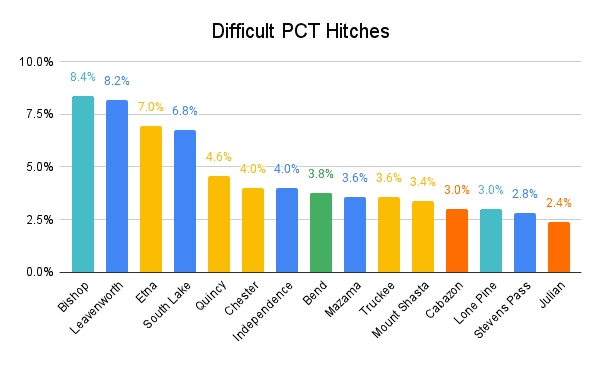
Remember, hitchhiking can be a very subjective/random experience. It may be you get a ride with the first car past at a place where others stand waiting for hours. Don’t start crying if nobody picks you up after an hour and don’t hate on people who call a Lyft/Uber/taxi (definitely an option at some trailheads).
Dietary Restrictions
Not all hikers can subsist on gas station beef jerky and trail mix. I ask hikers about their dietary restrictions, what they were, and how much trouble the restriction caused during their resupply over the course of the trail.
Dietary Restrictions
- 30.9% Yes
- 69.1% No

Specific Dietary Restrictions
- 56.3% Vegetarian
- 14.6% Vegan
- 13.5% Dairy Free
- 11.5% Pescatarian
- 8.3% Gluten Free
- 3.1% Kosher
- 2.1% Beef-free
- 2.1% Histamine intolerance
- 1% Diabetic
- 1% Keto
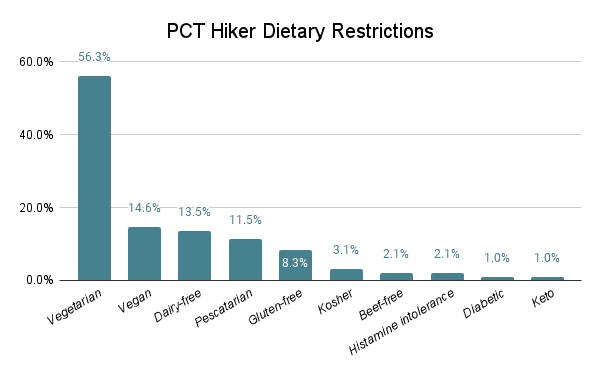
Trouble With Dietary Restrictions
I asked hikers with dietary restrictions, on a scale of 0 to 10 (0 being easy, 10 being difficult), how difficult it was to accommodate their diets while on the trail.
- 9.0 – Histamine Intolerance
- 4.9 – Gluten-Free
- 3.7 – Kosher
- 3.4 – Vegan
- 2.9 – Dairy-Free
- 2.6 – Vegetarian
- 2.5 – Beef-Free
- 1.8 – Pescatarian
- 1.0 – Keto
- 1.0 – Diabetic
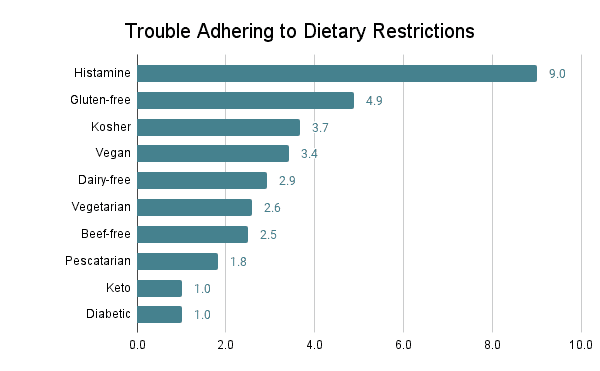
Resupply Advice
Enough with the numbers, colors, graphs, labels, and bulleted lists of places you may or may not have ever heard of. What did thru-hikers have to say about Pacific Crest Trail resupply? The following are pieces of advice, each from an individual hiker, regarding PCT resupply.
- I purchased a lot of food/snacks before the trail, prepared boxes ahead of time, and left them unsealed and without a mailing address so items could be added if need be. After some time and more experience resupplying, I had a much better idea of the things I wanted to eat which was very different from what I had packed in the resupply boxes ahead of time. I ended up bulk ordering a number of items on Amazon, shipped them to my boyfriend’s house, and had him reassemble the boxes (taking out what I wasn’t eating and adding in some of the new items I had ordered) as he shipped them. I wish I had only purchased food for the few boxes I would need early in the trail and put together lists for him to assemble the later boxes once I figured out what I liked.
- Don’t send boxes to anywhere that has a decent supply. Learn what you like before buying a large amount of it. Variety is key. Even if you love Peanut M&M’s, you can still tire of it, so mix it up. The big trade-off between sending packages and buying food on the trail is with sending packages you can send exactly what you plan to send, but the downside is you don’t know what you’re going to like after a few weeks. The benefit of buying food on the trail is that as your tastes change, you can buy what you like. The downside is many resupply locations have crap variety so you may be stuck with things you don’t like.
- Any place you can pick up a box without leaving the trail (or that’s close to the trail), send a box! I was so much happier to avoid the stress and money suck of towns with resupply boxes and would enjoy town more when I actually went in.
- Don’t over-plan your food, resupply boxes aren’t necessary – I sent zero and never had a problem finding food. In sections with lots of on-trail options (e.g. Oregon resorts), carry less food and buy a little at each stop. The perfect resupply simultaneously felt like too much food and not enough food. Pay attention to what you have left over and buy less of that next time. Pack out fun/dumb things as often as possible. Leftover pizza is wonderful on the first night out of town. If you like spice, buy red pepper flakes and put them in a small ziplock – much easier than finding hot sauce. Peanut butter + honey tortillas never got old. Carry olive oil and put it in every meal. Couscous is one of the fastest meals. Fruit snacks and gummy bears/worms were often the only things I felt like eating. On-trail TACOOO NIGHTTTT is the best, team up to pack out supplies. Sugary cereal is great for grazing. Beyond Meat jerky is good. Experiment with cold soaking, even if you carry a stove.
- As a first-time thru-hiker, I’d packed a few food boxes for shorter hikes but not for something like this. I mailed one box ahead of time and packed a few more. I found I dramatically underestimated what I’d want of some things, and overestimated other things. Think about your resupply through Idyllwild, but don’t stress about it past there. The best play is to pack some boxes for yourself from a town with a good grocery store once you’re on the trail for several weeks and know what you want. Packing more ahead of time will just lead to waste.
- As somebody who has dietary restrictions (vegan, no onion or garlic), making my own dehydrated meals from harmony house was super helpful. I was able to have extremely healthy dinners every day. I sent a lot of resupply boxes that honestly worked really well for me. Some of the smaller areas are extremely expensive, especially having a limited diet. For bigger towns, I would send a box of my pre-made dinners and the supplement with bars, snacks, candy, electrolytes, etc which was super helpful and switched up my diet. Also highly recommend turmeric capsules.
- Don’t just send a box somewhere because people around you are. If you’re flexible in items you can purchase and are willing to spend a bit more, you may not need to send a box.
But most of all – have fun out there! And don’t die.
Support the Survey
Every year, I get a lot of people asking how to support the surveys. Beyond sharing them with your close-knit bubble of weird hiker friends, the best way to support the survey is to contribute via Patreon. You’ll get access to exclusive posts, discount codes, live streams, and super, extra cool stickers so that everyone will know how cool you are.
If you’re not into Patreon, that’s cool; you can Venmo @halfwayanywhere, Cash app $halfwayanywhere, or PayPal moc.erehwynayawflah@tcatnoc
This is not expected. The data collected in the survey will always be free and accessible to everyone who wants/needs it. Your support is much appreciated and helps pay the website (and survey) bills.
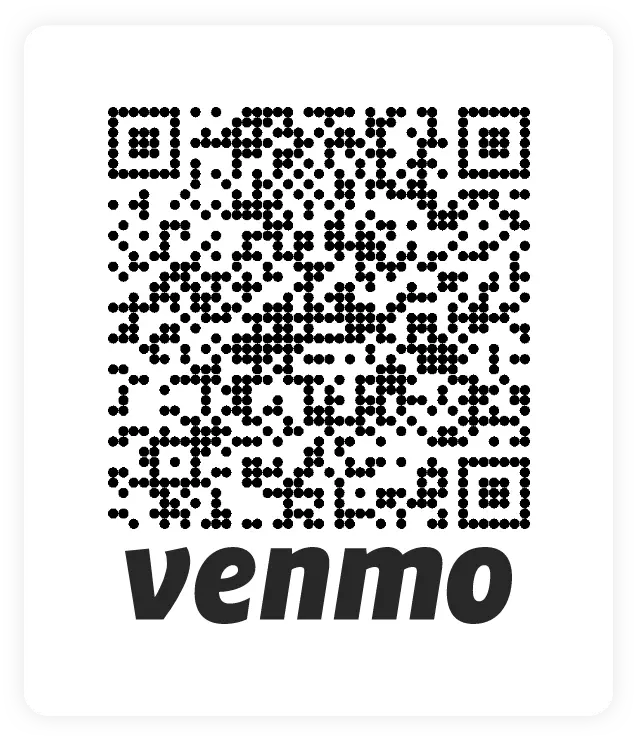

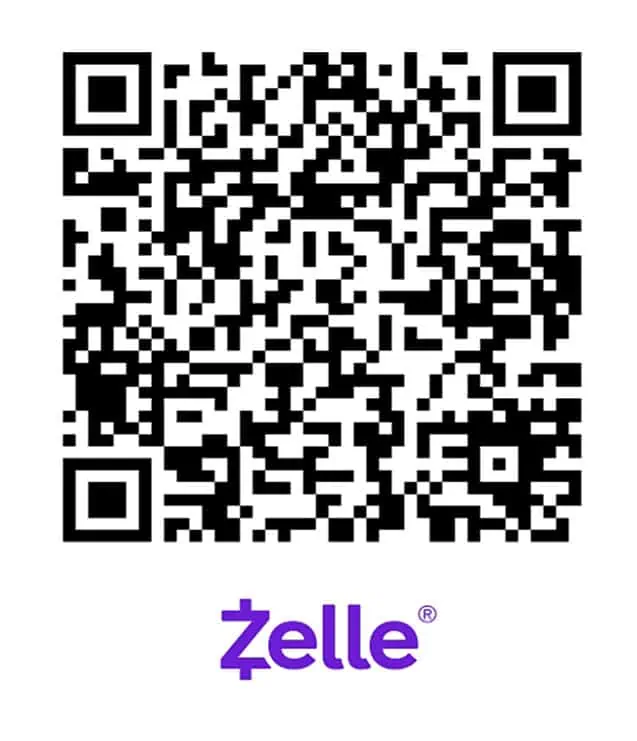
Pacific Crest Trail Survey Collection
If there is anything you can think of that would make this information on resupply more useful (or any more resupply-related cross-referencing you would like to see), then please leave a comment and let me know.
For more on PCT Resupply, check out these posts.
Affiliate Disclosure: This page may contain affiliate links, which means I may receive small commissions for purchases made via these links at no additional cost to you. This helps pay the bills and keep the site up and running. Thank you for your support!

